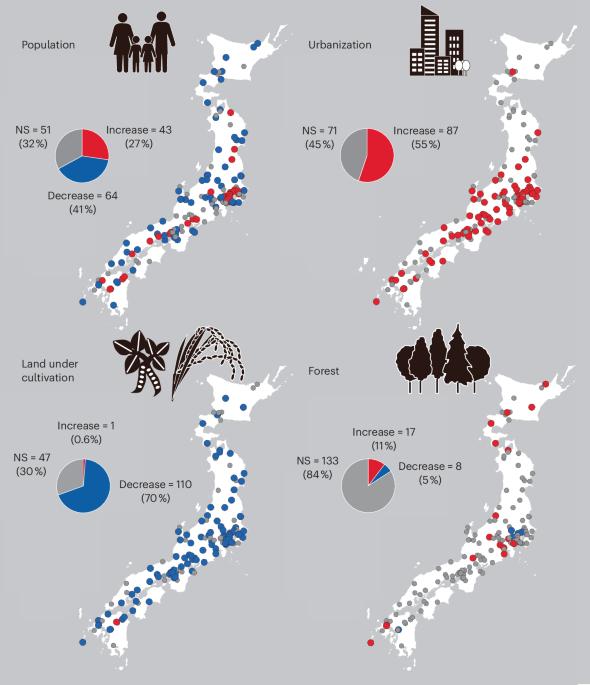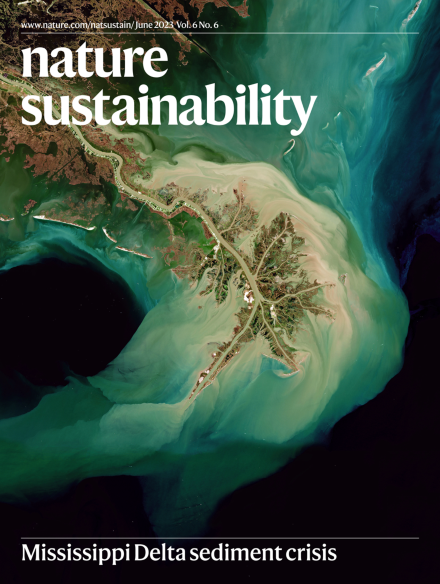Biodiversity change under human depopulation in Japan
IF 27.1
1区 环境科学与生态学
Q1 ENVIRONMENTAL SCIENCES
引用次数: 0
Abstract
Global studies consistently highlight a direct relationship between habitat and species losses, and human population and economic growth. Nevertheless, countries are experiencing below-replacement human fertility and starting to depopulate; among these countries, Japan is a global forerunner. To better understand whether human depopulation automatically yields environmentally restorative outcomes, we examine the impacts of human depopulation on aspects of biodiversity in Japan. Alongside population, land use and surface temperature, we analyse biodiversity change among 464 taxonomic species of bird, butterfly, firefly and frog egg masses, and 2,922 native and non-native plant species in wooded, agricultural and peri-urban landscapes across Japan over periods of 5–17 years from 2004. Irrespective of human population increase or decrease, biodiversity losses continue among most species studied mainly because of change in agricultural land use, either due to urbanization, disuse and abandonment, or intensification. Only where human numbers are currently stable, biodiversity is also more stable, although we anticipate that this may also change as ageing deepens into depopulation in these areas. We conclude by urging countries facing depopulation to account for its outcomes in their biodiversity conservation and restoration strategies. Human population growth over the past few decades has had detrimental impacts on biodiversity; however, several countries, such as Japan, are experiencing below-replacement human fertility leading to depopulation. This study examines the impact of human depopulation on biodiversity levels across Japan.

人口减少下日本生物多样性的变化
全球研究一致强调栖息地和物种丧失、人口和经济增长之间的直接关系。然而,一些国家正在经历低于更替水平的人口生育率,并开始人口减少;在这些国家中,日本是全球的先行者。为了更好地理解人口减少是否会自动产生环境恢复结果,我们研究了日本人口减少对生物多样性方面的影响。在人口、土地利用和地表温度的基础上,分析了2004年以来5-17年间日本森林、农业和城郊景观中464种鸟类、蝴蝶、萤火虫和蛙卵群的生物多样性变化,以及2922种本地和非本地植物的生物多样性变化。无论人口增加或减少,所研究的大多数物种的生物多样性仍在继续丧失,这主要是由于城市化、废弃和遗弃或集约化导致的农业土地利用的变化。只有在人口数量目前稳定的地方,生物多样性才会更加稳定,尽管我们预计,随着这些地区人口老龄化的加深,这种情况也可能发生变化。最后,我们敦促面临人口减少的国家在其生物多样性保护和恢复战略中考虑其结果。过去几十年的人口增长对生物多样性产生了不利影响;然而,一些国家,如日本,正在经历低于更替的人类生育率,导致人口减少。本研究考察了日本人口减少对生物多样性水平的影响。
本文章由计算机程序翻译,如有差异,请以英文原文为准。
求助全文
约1分钟内获得全文
求助全文
来源期刊

Nature Sustainability
Energy-Renewable Energy, Sustainability and the Environment
CiteScore
41.90
自引率
1.10%
发文量
159
期刊介绍:
Nature Sustainability aims to facilitate cross-disciplinary dialogues and bring together research fields that contribute to understanding how we organize our lives in a finite world and the impacts of our actions.
Nature Sustainability will not only publish fundamental research but also significant investigations into policies and solutions for ensuring human well-being now and in the future.Its ultimate goal is to address the greatest challenges of our time.
 求助内容:
求助内容: 应助结果提醒方式:
应助结果提醒方式:


